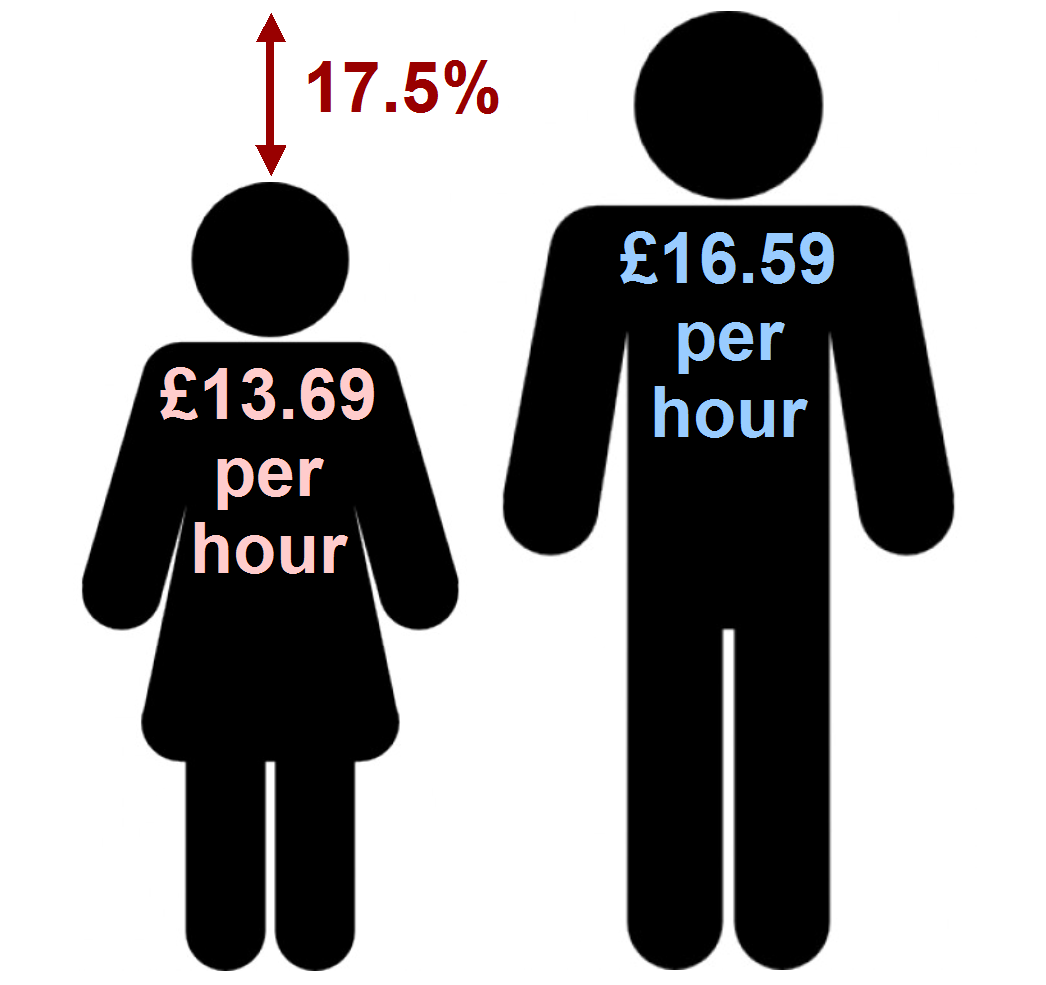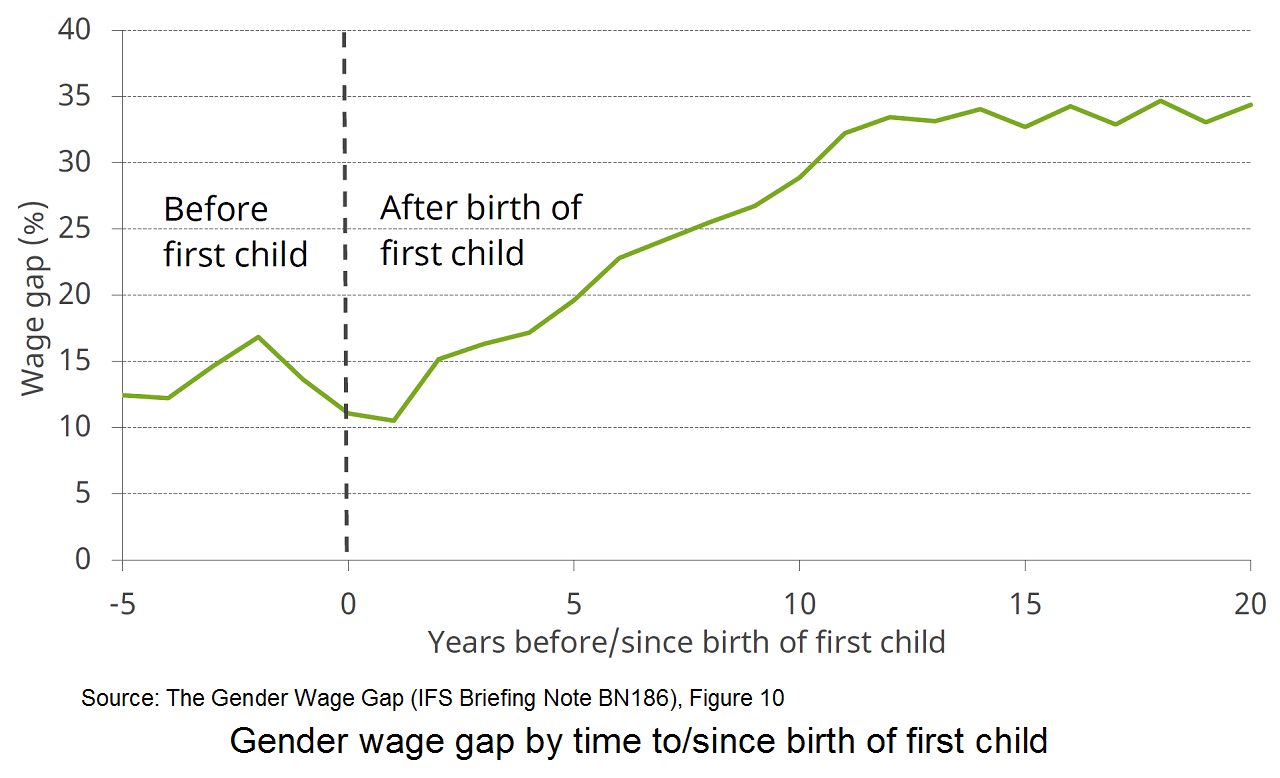 Women in the UK on average earn less per hour than men. According to the Annual Survey of Hours and Earnings, the mean hourly pay for women in 2015 was 17.5% less than that for men. This figure is for all employees, full and part time. As far as full-time employees is concerned, the gap was slightly smaller at 13.9%. Nevertheless, as you can see from Table 6 in the linked Excel file, these gaps have decreased in recent years – but only slightly.
Women in the UK on average earn less per hour than men. According to the Annual Survey of Hours and Earnings, the mean hourly pay for women in 2015 was 17.5% less than that for men. This figure is for all employees, full and part time. As far as full-time employees is concerned, the gap was slightly smaller at 13.9%. Nevertheless, as you can see from Table 6 in the linked Excel file, these gaps have decreased in recent years – but only slightly.
A recent paper from the Institute for Fiscal Studies has disaggregated the figures to give a better picture of this wage gap. It finds that having children is a major contributing factor to the gap. It also finds that this has a bigger impact on the earnings of graduates and those without a degree but with A levels.
On entry to the labour market, men and women earn roughly the same. People’s wages tend to rise during their 20s, but men’s rise slightly faster than women’s, causing a pay gap to open and widen – but slowly at first. Average (mean) men’s wages continue to grow during their 30s and a bit during their 40s. However, average women’s wages flatline. Thus the wage gap grows substantially, especially for the higher educated.
The paper argues that the arrival of children is a major contributing factor to this picture. It looks at the gap before and after the arrival of children. “The crucial observation is that the gap opens up gradually after the first child arrives and continues to widen for many years after that point.” By 12 years after the first child is born, the wage gap has widened to 33%.

The paper does not offer reasons for the small gap that exists before the arrival of children. But it does give possible reasons for the widening gap after having children. A major one, it suggests, has to do with labour market experience.
“As women are likely to do less paid work after the arrival of children, the level of labour market experience they have falls further and further behind that of their male counterparts, and the wage gap therefore widens.” They may also miss out on promotions.
Each year a woman spends away from the labour market is associated with an average 2% drop in pay compared with those who remain in work. For those with at least A levels, the penalty is 4%; but there is no drop in pay for those without A levels.
Other possible explanations include mothers taking work that requires a lower skill level, and at lower hourly pay, in order to gain flexibility in working hours. However, the evidence suggests that women who move to part-time work on having a child suffer no immediate drop in pay. But their hourly pay does grow more slowly, thus contributing to a widening of the gap.
Another explanation is employers exercising market power to discriminate against women with children. The paper does not consider this explanation.
The articles discussing the paper look at policy implications and identify various things that can be done to narrow the gap. Read the paper and articles and try answering the questions below.
Videos and podcasts
 IFS: gender pay gap widens after first child Compendium of News Reports from BBC News at Six, Channel 4 News, ITV News at Ten and BBC Newsnight from Incorrigible Forever on YouTube (23/8/16)
IFS: gender pay gap widens after first child Compendium of News Reports from BBC News at Six, Channel 4 News, ITV News at Ten and BBC Newsnight from Incorrigible Forever on YouTube (23/8/16)
 Gender Pay Gap Hits Women With Children Hardest Sky News (23/8/16)
Gender Pay Gap Hits Women With Children Hardest Sky News (23/8/16)
 In Business: Supportive partner = success at work World of Business, BBC Radio 4, Peter Day (25/8/15)
In Business: Supportive partner = success at work World of Business, BBC Radio 4, Peter Day (25/8/15)
 Gender Pay Gap More or Less, BBC Radio 4, Tim Harford (26/8/16)
Gender Pay Gap More or Less, BBC Radio 4, Tim Harford (26/8/16)
 Gender pay gap: Why do mums increasingly earn less? BBC Victoria Derbyshire programme (23/8/16)
Gender pay gap: Why do mums increasingly earn less? BBC Victoria Derbyshire programme (23/8/16)
Articles
UK women still far adrift on salary and promotion as gender pay gap remains a gulf The Guardian, Katie Allen (23/8/16)
Gender pay gap: mothers returning to work earn a third less than men The Telegraph, Tim Wallace (23/8/16)
Mothers’ pay lags far behind men BBC News (23/8/16)
Four ways the gender pay gap isn’t all it seems BBC News Magazine, Simon Maybin (29/8/16)
Six ways to tackle the gender pay gap BBC News, Emma Atkinson (23/8/16)
Wage gap for UK women unchanged in 20 years Financial Times, Gemma Tetlow (23/8/16)
The UK’s slow march to gender pay equality Financial Times (23/8/16)
Gender Pay Gap For Mothers Widens For 12 Years After Having Children, New Research Finds Huffington Post, Jack Sommers (23/8/16)
Motherhood costs women a third of their salary compared to men, report reveals Independent, Joe Watts (23/8/16)
The gender pay gap means that more women will be in poverty later in life – but there is something the government can do Independent, Claire Turner (26/8/16)
Gender pay gap won’t close until 2069, says Deloitte The Guardian, Katie Allen (24/9/16)
Papers and Reports
Gender wage gap grows year on year after childbirth as mothers in low-hours jobs see no wage progression IFS Press Release (23/8/16)
The Gender Wage Gap IFS Briefing Note BN18, William Elming , Robert Joyce and Monica Costa Dias (23/8/16)
Women in STEM: Technology, career pathways and the gender pay gap Deloitte (September 2016)
Data
Gender pay differences: Annual Survey of Hours and Earnings: 2015 Provisional Results ONS Statistical Bulletin (18/11/15)
All data related to Annual Survey of Hours and Earnings: 2015 Provisional Results ONS datasets (18/11/15)
ASHE 1997 to 2015 selected estimates (See Tables 1 to 4, 6 and 9) ONS dataset (18/11/15)
All Employees – ASHE: Table 1 ONS dataset (18/11/15)
Questions
- Identify possible reasons for the wage gap between men and women.
- Why is the median wage gap different from the mean wage gap?
- Why is the wage penalty for periods without work greater for more highly educated women?
- To what extent is the gender wage gap a reflection of marginal productivity differences?
- Is the gender pay gap primarily about men and women being paid differently for doing the same job?
- What evidence is provided by the Chartered Management Institute (CMI) on women’s lack of pay progression?
- What could the government do to reduce the wage gap?
- Discuss the relative effectiveness of different policy alternatives.
 Research published by the Institute for Fiscal Studies shows that graduates from wealthier family backgrounds earn significantly more than those from poorer backgrounds. If you compare the 20% of graduates from the richest backgrounds with the remaining 80%, the average earnings gap in 2012/13, 10 years after graduation, was £8000 per year for men and £5300 for women. Even when you take graduates in similar degrees from similar universities, there is still a gap of around 10% between those from richer and those from poorer backgrounds.
Research published by the Institute for Fiscal Studies shows that graduates from wealthier family backgrounds earn significantly more than those from poorer backgrounds. If you compare the 20% of graduates from the richest backgrounds with the remaining 80%, the average earnings gap in 2012/13, 10 years after graduation, was £8000 per year for men and £5300 for women. Even when you take graduates in similar degrees from similar universities, there is still a gap of around 10% between those from richer and those from poorer backgrounds.
 The research also shows that in 2012/13, 10 years after graduation, the median earnings for economics graduates was the second highest of any subject (just behind graduates in medicine) and that at the 90th percentile economics graduates had the highest earnings (£93 900 for women and £121 400 for men) of any subject. In fact, graduates in economics were the only males at this percentile earning over £100 000. (Click here for a PowerPoint of the chart.) As the Press Release to the IFS working paper states:
The research also shows that in 2012/13, 10 years after graduation, the median earnings for economics graduates was the second highest of any subject (just behind graduates in medicine) and that at the 90th percentile economics graduates had the highest earnings (£93 900 for women and £121 400 for men) of any subject. In fact, graduates in economics were the only males at this percentile earning over £100 000. (Click here for a PowerPoint of the chart.) As the Press Release to the IFS working paper states:
For males, it is estimated that approximately 12% of economics graduates earned above £100 000 some ten years after graduation; by contrast, 6% of those studying medicine or law earned more than £100 000.
6% of those studying medicine or law earned more than £100 000.
For females, it is estimated that approximately 9% of economics graduates earned above £100 000 some ten years after graduation; by contrast, just 1% of those studying medicine and 3% of those studying law did so.
For some subjects, graduates earned little more than non-graduates.
Those studying the creative arts had the lowest earnings, and indeed earned no more on average than non-graduates.
The research also shows that earnings vary substantially by gender and university. For those earning £8000 or more, the median earnings for male graduates 10 years after graduation was £30 000 (compared with £21 000 for non-graduates), whereas for women it was £27 000 (compared with £18 000 for non-graduates).
Earnings are substantially higher for graduates from some universities, such as Oxford, Cambridge and the LSE. “At the other end of the spectrum, there were some institutions (23 for men and 9 for women) where the median graduate earnings were less than those of the median non-graduate ten years on.” Differences in graduate earnings by university tend to compound the difference by students’ family background as those from poorer backgrounds disproportionately attend universities with lower average graduate earnings by discipline.
The following articles consider the findings and their implications for higher education policy
Articles
Graduates from wealthy backgrounds reap earnings benefits Times Higher Education, John Morgan (13/4/16)
Graduate Earnings Guided By Parents’ Wealth, Institute For Fiscal Studies Report Finds Huffington Post, George Bowden (13/4/16)
Graduates from poorer backgrounds earn less than richer peers on same course, major international study finds Independent. Oliver Wright (13/4/16)
Richer students have higher graduate income, study finds The Guardian (13/4/16)
Want a Higher Salary? It Helps If You’re a Man With Rich Parents Bloomberg, Robert Hutton (13/4/16)
Economics graduates are in the money Why Study Economics? Economics in Action blog (15/4/16)
IFS paper
What and where you study matter for graduate earnings – but so does parents’ income IFS Press Release (13/4/16)
How English domiciled graduate earnings vary with gender, institution attended, subject and socio-economic background IFS Working Paper W16/06, Jack Britton, Lorraine Dearden, Neil Shephard and Anna Vignoles (13/4/16)
Data
Free Online Statistics – Students & qualifiers Higher Education Statistics Agency (HESA)
Applications and acceptances for types of higher education course – 2015 UCAS
What do graduates do? Higher Education Careers Services Unit
Questions
- For what reasons are graduates from rich backgrounds likely to earn substantially more than graduates from poor backgrounds?
- Why are graduates in economics likely to earn more than graduates in other subjects, especially those in the top percentile of earners from any given subject?
- How might marginal productivity help to explain the differences in earnings of different graduates?
- What are meant by ‘soft skills’. Why may students from richer backgrounds have better soft skills in the context of (a) university admission and (b) getting a job on graduation?
- Why are female graduates likely to earn less than male graduates with the same class of degree in the same subject?
- What could be done by (a) universities and (b) the government to increase social mobility?
- Do you think that the findings of the research have implications for the way students’ study is funded? Explain.
 The earnings gap between men and women is well-documented and depending on how we measure it, we get different figures. One of the most common measures is mean earnings per hour. The latest estimates suggest that women are paid around 20% less than men, though other data does give lower figures. Though actions have been taken to reduce the inequality between men and women, it still persists in many areas and this has led to plans for new league tables from Nicky Morgan.
The earnings gap between men and women is well-documented and depending on how we measure it, we get different figures. One of the most common measures is mean earnings per hour. The latest estimates suggest that women are paid around 20% less than men, though other data does give lower figures. Though actions have been taken to reduce the inequality between men and women, it still persists in many areas and this has led to plans for new league tables from Nicky Morgan.
The inequality gap has certainly come down. Back in 1970, the wage differential was around 37 per cent, so progress has been made, although the wage gap in the UK has stabilised somewhat. The gender wage gap is at least in part explained by occupations, as women have tended to be prevalent in some of the more poorly paid occupations. However, significant earnings differentials still exist within occupations. We see fewer women in the more senior positions; women tend to take career breaks and hence this can cause more investment into training and promoting men. Furthermore, we often simply see some form of prejudice or discrimination whereby women are just paid less than men, despite the Equal Pay Act.

As a means of combatting this inequality, Nicky Morgan, the Women and Equalities Minister, has announced plans that will require private companies and voluntary organisations employing more than 250 workers to reveal their pay gap. They will have to produce this information online and this will a means to bring down the inequality that exists between men and women in the same occupations. The first League Table of this pay gap will be published in April 2018 so companies will have to begin compiling the information from April 2017. This has received criticism from some, as it is not starting soon enough, but it is seen as a step in the right direction.
Carolyn Fairbairn, CBI Director-General warned that these League Tables shouldn’t be used to name and shame firms, as many factors might explain wage differentials. She noted:
“Where reporting can be useful is as a prompt for companies to ask the right questions about how they can eradicate the gender pay gap … The government should consult closely with business to ensure that this new legislation helps close the gender pay gap, rather than ending up as a box-ticking exercise.”
Clearly there are some close links between the gender pay gap and concerns about poverty and minimum wages and although the League Tables perhaps should not be used to name and shame, one might think it is inevitable that this is how they will be viewed. The following articles consider Nicky Morgan’s inequality plans.
Reports
Gender Pay Gap European Commission
Annual Survey of Hours and Earnings, 2015 Provisional Results Office for National Statistics (November 2015)
Pay gap reporting Equal Pay Portal2016
Articles
Gender pay gap reporting for big firms to start in 2018 Guardian, Rowena Mason (12/02/16)
Gender pay gap to be revealed by employers to tackle inequality Financial Times, Sarah O’Connor (12/02/16)
Firms forced to reveal gender pay gap BBC News (12/02/16)
Gender pay gap League Tables to ‘name and shame’ companies Telegraph, Steven Swinford (12/02/16)
UK companies must reveal gender pay gap under new plans Independent, Oliver Wright (12/02/16)
Companies told to publish gender pay gap Sky News (12/102/16)
Gender pay gap: Business groups mixed on Nicky Morgan’s new name-and-shame plans International Business Times, Bauke Schram (12/02/16)
Now every firm with more than 250 staff must put gender pay gap data online in move to encourage companies to reward staff equally Mail Online, Jack Doyle and Rosie Taylor (12/02/16)
Questions
- Use a labour market diagram to explain how gender pay gaps can emerge based on different marginal products.
- How can gender pay gaps emerge because of women taking career breaks and being less geographically mobile?
- Use information on the ONS website to compare pay differentials across occupations. Are the biggest and smallest differentials where you would expect?
- There are numerous reasons why men have traditionally been paid more than women. Which reasons could be said to be irrational and which are rational?
- If employers were forced to give genuinely equal pay for equal work, how would this affect the employment of women and men? What would determine the magnitude of these effects?
- Do you think this naming and shaming will be effective in reducing the gender pay gap amongst the largest companies? Can you suggest any other policy options?
- If the Equal Pay Act is in place, why can companies still pay women less?
 Women in the UK on average earn less per hour than men. According to the Annual Survey of Hours and Earnings, the mean hourly pay for women in 2015 was 17.5% less than that for men. This figure is for all employees, full and part time. As far as full-time employees is concerned, the gap was slightly smaller at 13.9%. Nevertheless, as you can see from Table 6 in the linked Excel file, these gaps have decreased in recent years – but only slightly.
Women in the UK on average earn less per hour than men. According to the Annual Survey of Hours and Earnings, the mean hourly pay for women in 2015 was 17.5% less than that for men. This figure is for all employees, full and part time. As far as full-time employees is concerned, the gap was slightly smaller at 13.9%. Nevertheless, as you can see from Table 6 in the linked Excel file, these gaps have decreased in recent years – but only slightly.
 IFS: gender pay gap widens after first child Compendium of News Reports from BBC News at Six, Channel 4 News, ITV News at Ten and BBC Newsnight from Incorrigible Forever on YouTube (23/8/16)
IFS: gender pay gap widens after first child Compendium of News Reports from BBC News at Six, Channel 4 News, ITV News at Ten and BBC Newsnight from Incorrigible Forever on YouTube (23/8/16) Gender Pay Gap Hits Women With Children Hardest Sky News (23/8/16)
Gender Pay Gap Hits Women With Children Hardest Sky News (23/8/16) In Business: Supportive partner = success at work World of Business, BBC Radio 4, Peter Day (25/8/15)
In Business: Supportive partner = success at work World of Business, BBC Radio 4, Peter Day (25/8/15) Gender Pay Gap More or Less, BBC Radio 4, Tim Harford (26/8/16)
Gender Pay Gap More or Less, BBC Radio 4, Tim Harford (26/8/16) Gender pay gap: Why do mums increasingly earn less? BBC Victoria Derbyshire programme (23/8/16)
Gender pay gap: Why do mums increasingly earn less? BBC Victoria Derbyshire programme (23/8/16)



